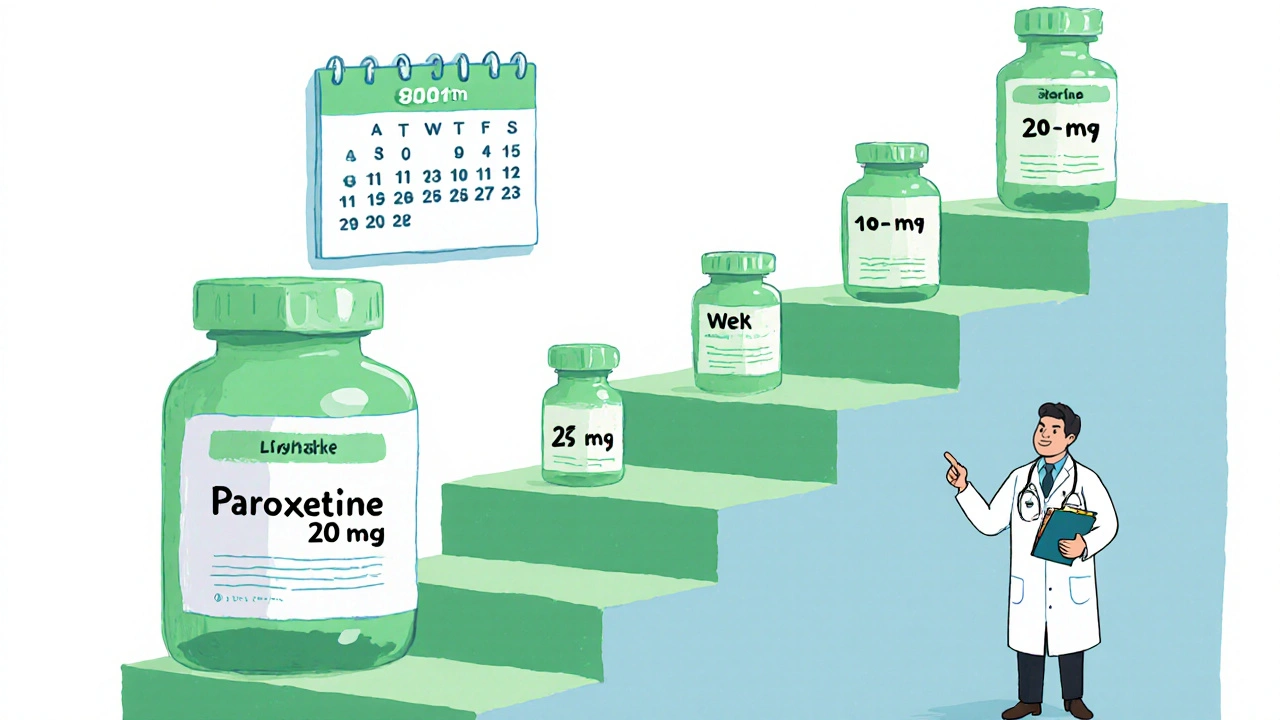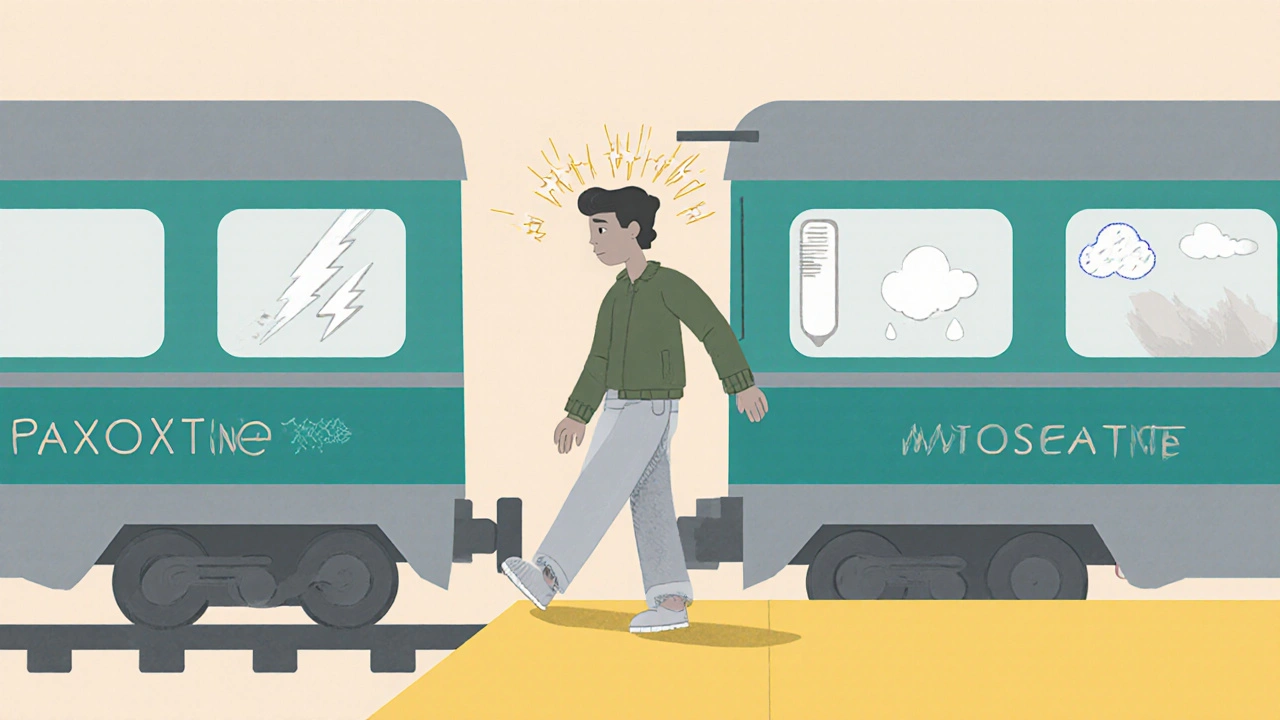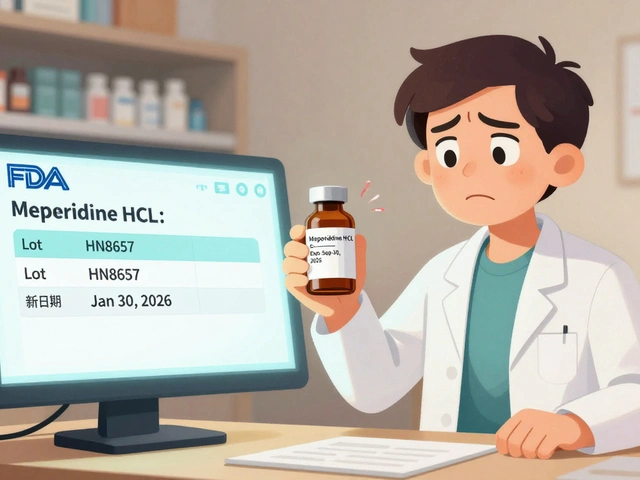Antidepressant Taper Calculator
Personalized Taper Plan
This tool helps determine a safe taper schedule based on your antidepressant type and treatment duration. Always consult your doctor before making changes to medication.
Stopping an antidepressant after weeks or months can feel like stepping off a moving train. Some people get a few days of mild fatigue, while others experience electric‑shock sensations, dizziness, and intense anxiety that make them wonder if the drug is still in their system. That unsettling period is called Antidepressant Discontinuation Syndrome-a withdrawal condition that appears when an antidepressant is reduced, switched, or stopped after at least a month of continuous use. Knowing what to expect, how to tell it apart from a relapse, and the safest way to taper can turn a scary experience into a manageable one.
Key Takeaways
- Symptoms usually start 2‑4 days after a missed dose and fade within 1‑2 weeks for most drugs.
- Short‑half‑life meds like paroxetine and venlafaxine cause the most severe withdrawal.
- Gradual tapering (4‑8 weeks or longer) cuts the risk by more than 60%.
- Re‑starting the original drug often resolves symptoms within 72 hours.
- Protracted withdrawal can last months; early recognition and support are crucial.
What Is Antidepressant Discontinuation Syndrome?
The condition was first named by Eli Lilly to separate antidepressants from drugs that cause classic addiction. Today experts agree it’s a genuine withdrawal syndrome-your brain and body have adapted to higher serotonin or norepinephrine levels, and when the drug disappears those adaptations swing back, producing a cluster of physical and mental symptoms.
Who Is Most at Risk?
Risk hinges on three main factors: the medication’s half‑life, the length of treatment, and individual physiological differences.
Selective serotonin reuptake inhibitors (SSRIs)-a class of antidepressants that boost serotonin such as paroxetine, sertraline, and fluoxetine are the most prescribed. Paroxetine (half‑life ≈ 21 hours) and venlafaxine (half‑life 5‑11 hours, a serotonin‑norepinephrine reuptake inhibitor (SNRI)-an antidepressant that raises both serotonin and norepinephrine) are notorious for severe withdrawal because the drug clears from the bloodstream quickly.
Long‑acting agents like fluoxetine (half‑life 4‑6 days) provide a built‑in “buffer,” so tapering can be gentler. Tricyclic antidepressants (TCAs) and monoamine oxidase inhibitors (MAOIs) each have their own quirks-TCAs can cause tremors and balance issues, while MAOI discontinuation may trigger aggression or even psychosis.
Additional high‑risk scenarios include pregnancy (the body’s hormonal shifts amplify symptoms), abrupt generic switches that aren’t bio‑equivalent, and any sudden stop after years of therapy.
Typical Symptoms - The FINISH Mnemonic
Clinicians often use the mnemonic FINISH to remember the most common clusters:
- Flu‑like symptoms - fatigue, muscle aches, headaches, feverish chills.
- Insomnia - difficulty falling asleep, vivid dreams, nighttime anxiety.
- Nausea - stomach upset, vomiting, loss of appetite.
- Imbalance - dizziness, vertigo, unsteady gait.
- Sensory disturbances - “brain zaps,” tingling, electric‑shock sensations.
- Hyperarousal - irritability, agitation, panic, rapid mood swings.
Real‑world reports add derealization, difficulty concentrating, suicidal thoughts, and even akathisia (inner restlessness). The intensity can vary from a mild headache to a full‑blown panic attack.
When Do Symptoms Appear and How Long Do They Last?
On average, symptoms surface within 2‑4 days after the dose is missed for short‑half‑life drugs, and as early as hours for ultra‑short agents like paroxetine. For long‑acting drugs, the window can stretch to a week.
Most people feel relief within 1‑2 weeks. However, up to 18.7 % of patients on SSRIs report symptoms persisting beyond three months, and a minority-around 5‑10 %-experience protracted withdrawal that lasts six months or longer. The Royal College of Psychiatrists notes rare cases stretching to a year.
Withdrawal vs. Relapse: Why It Matters
Both conditions can feature anxiety, low mood, and sleep problems, but the timeline is the giveaway. Withdrawal spikes quickly after the dose is cut and often eases within days of re‑starting the medication. Relapse, on the other hand, tends to develop more gradually, sometimes weeks after discontinuation, and may not vanish instantly if the drug is re‑prescribed.
Misreading withdrawal as a relapse can lead clinicians to increase the dose unnecessarily, reinforcing the cycle of dependence. Asking the patient for a precise symptom timeline is the simplest way to avoid this error.

How to Prevent Withdrawal: Smart Tapering Strategies
The cornerstone of prevention is a **gradual dose reduction** under medical supervision. Here are evidence‑backed steps:
- Choose a long‑half‑life alternative if you anticipate stopping-switch from paroxetine to fluoxetine a few weeks before the final taper.
- Use a titration schedule that reduces the dose by 10‑25 % every 1‑2 weeks for SSRIs, and every 2‑4 weeks for SNRIs like venlafaxine.
- Split the dose into twice‑daily increments to create smaller jumps.
- Monitor symptoms weekly using a simple checklist (e.g., the FINISH list) and adjust the taper speed if they flare up.
- Keep the original formulation handy for a quick “rescue” re‑introduction if symptoms become intolerable; most patients feel better within 48‑72 hours.
Clinical trials show that a well‑planned taper cuts the odds of severe withdrawal by **62 %** compared with abrupt stopping.
Managing Active Withdrawal Symptoms
If symptoms appear despite a careful taper, several tactics can help:
- Re‑start the last tolerated dose for a few days, then resume a slower taper.
- Supportive medications like low‑dose benzodiazepines for acute anxiety (short‑term only), antihistamines for nausea, or over‑the‑counter ibuprofen for muscle aches.
- Hydration and nutrition - staying well‑hydrated and eating small, frequent meals can ease GI upset.
- Mind‑body practices - gentle yoga, breathing exercises, and mindfulness have reduced perceived intensity in patient surveys.
- Professional counseling - cognitive‑behavioral therapy can address the emotional surge that often accompanies withdrawal.
Remember, most symptoms respond quickly once the medication is re‑introduced; if they linger beyond three days, check for other medical causes.
Special Situations
Pregnancy: Stopping an antidepressant without a plan can jeopardize both mom and baby. Guidelines advise a slow taper, often extending beyond eight weeks, and close obstetric‑psychiatric collaboration.
Formulation switches: Not all generics are bio‑equivalent. A sudden dip in blood levels can trigger withdrawal even though the patient believes they’re staying on the same drug.
Protracted withdrawal: For those whose symptoms linger months, a multidisciplinary approach-psychiatrist, primary care, and a psychotherapist-offers the best chance of recovery. Some clinicians use low‑dose antidepressants as a “maintenance bridge” while the brain recalibrates.
Comparison: Short‑Half‑Life vs. Long‑Half‑Life Antidepressants
| Attribute | Short‑Half‑Life (e.g., paroxetine, venlafaxine) | Long‑Half‑Life (e.g., fluoxetine, sertraline) |
|---|---|---|
| Half‑life | ≈ 1‑2 days | ≈ 4‑6 days (fluoxetine) or > 1 day (sertraline) |
| Typical onset of withdrawal | Hours‑2 days | 4‑7 days |
| Common symptoms | Brain zaps, nausea, dizziness, anxiety | Mild flu‑like symptoms, insomnia |
| Recommended minimum taper | 8‑12 weeks | 4‑6 weeks |
| Risk of protracted withdrawal | Higher (≈ 10‑15 %) | Lower (≈ 5 %) |
Bottom Line
Antidepressant discontinuation syndrome is real, predictable, and mostly manageable. The best defense is a personalized taper plan, open communication with your prescriber, and quick action if symptoms flare. By respecting the brain’s adaptation process, you can step off the medication with far fewer shocks.

How soon after stopping an antidepressant do withdrawal symptoms start?
For short‑half‑life drugs like paroxetine, symptoms can appear within a few hours to two days. Longer‑acting agents such as fluoxetine usually show signs after about four to seven days.
Can I stop an antidepressant abruptly if I’ve been on it for a short time?
Even a few weeks of continuous use can create neuroadaptations. Abrupt stops raise the chance of severe withdrawal, especially with short‑half‑life drugs. A gradual taper is always safer.
What are “brain zaps” and why do they happen?
Brain zaps are fleeting electric‑shock sensations, usually felt in the head or neck. They arise when serotonin levels drop suddenly as the antidepressant clears, causing temporary neuronal firing irregularities.
Is it safe to switch from a short‑half‑life antidepressant to a long‑half-life one before tapering?
Yes. Switching to a longer‑acting drug like fluoxetine provides a “buffer” that smooths the decline in blood levels, making the subsequent taper gentler and lowering withdrawal risk.
What should I do if withdrawal symptoms last more than a few weeks?
Contact your prescriber promptly. They may restart the medication briefly, extend the taper, or add supportive treatments. In persistent cases, a referral to a psychiatrist experienced in protracted withdrawal is advisable.







Doreen Collins
October 24, 2025 AT 14:15 PMWow, that rundown of the FINISH mnemonic really hits home – I’ve seen the “brain zaps” scare people half to death. If you’re tapering, try splitting the dose like the guide says; the smaller jumps can make a huge difference. Keep a simple checklist handy so you can spot when something’s shifting toward a relapse rather than withdrawal. And remember, re‑starting the med for a couple of days is not a failure, it’s just part of the safety net. You’ve got this, one steady step at a time.
Casey Morris
October 25, 2025 AT 16:46 PMMy dear fellow wanderers of the psych‑pharmaceutical realm, let us not forget that abrupt cessation is, quite frankly, a culinary disaster for the synaptic palate; the brain, after all, craves a gradual diminuendo, not a sudden fortissimo, and the literature-oh, the revered meta‑analyses-underscore this with a chorus of statistically significant findings, which, I assure you, are not mere academic fluff but a beacon for the weary.
Teya Arisa
October 26, 2025 AT 20:33 PMDear readers, the phenomenon commonly labeled as Antidepressant Discontinuation Syndrome warrants a measured, evidence‑based approach; first and foremost, clinicians must differentiate between true relapse and pharmacologic withdrawal, as the therapeutic ramifications diverge substantially. The temporal profile of symptoms-often emerging within two to four days for short‑half‑life agents-serves as a reliable diagnostic clue, whereas relapse tends to manifest more insidiously over weeks. A judicious taper schedule, typically reducing the dose by no more than 10 % every one to two weeks for SSRIs, mitigates neuroadaptive shock and preserves functional stability. When transitioning from a short‑half‑life compound such as paroxetine to a longer‑acting analogue like fluoxetine, the inter‑mediation period provides a pharmacokinetic “buffer” that smoothes plasma fluctuations. Ongoing symptom monitoring, ideally via a structured checklist encompassing the FINISH domains, empowers both patient and provider to intervene promptly should adverse effects arise. Should withdrawal symptoms culminate despite a cautious taper, reinstating the most recent tolerable dose for a brief window-often 48 to 72 hours-has been shown to ameliorate distress in the majority of cases. Adjunctive therapies, ranging from short‑course benzodiazepines for acute anxiety to supportive psychotherapy, can further buttress the patient’s coping repertoire without compromising the taper’s integrity. Nutrition and hydration, though seemingly mundane, play non‑trivial roles in attenuating gastrointestinal upset and general malaise. Special populations, notably pregnant individuals, demand an even more protracted taper, frequently exceeding eight weeks, to safeguard both maternal and fetal well‑being. In instances of protracted withdrawal persisting beyond three months, a multidisciplinary strategy-encompassing psychiatry, primary care, and psychotherapy-offers the most comprehensive avenue for recovery. Moreover, clinicians should remain vigilant for rare but serious sequelae, such as emergent psychosis in the context of MAOI discontinuation, and act decisively. It is incumbent upon prescribers to convey these nuances with empathy and clarity, thereby demystifying the tapering journey and fostering patient adherence. Ultimately, the goal is not merely the cessation of medication, but the restoration of neuronal equilibrium in a manner that honors the individual’s lived experience. Patients are encouraged to maintain open communication channels with their prescriber, reporting any unexpected spikes in anxiety or somatic complaints promptly. Such collaborative vigilance not only enhances safety but also reinforces the therapeutic alliance throughout the tapering process. 🌱🙂
Kester Strahan
October 28, 2025 AT 01:43 AMYo, I feel ya on the “synaptic palate” vibe-basically the CNS is just tryna recalibrate its monoamine set‑point, so when you yank the SSRI, you get a rebound surge of ↓5‑HT and a cascade of NMDA‑mediated excitotoxic chatter. In lay‑terms, think of it as the brain’s GPS losing satellite lock; you get those “zaps” as it re‑boots. If you drop the dose in micro‑increments (like 5 mg slices), you keep the receptor occupancy from nosediving, which smooths the withdrawal curve. Also, watch the CYP450 interactions when you switch to fluoxetine; its inhibitor profile can actually prolong the tail of the taper. TL;DR: pace it, monitor the neurochemical feedback, and don’t let the jargon scare you.
Lindy Hadebe
October 29, 2025 AT 04:06 AMProtracted withdrawal is a legitimate clinical concern.
Ekeh Lynda
October 30, 2025 AT 07:53 AMThe literature on antidepressant tapering often feels like a maze of conflicting guidelines but the core principle remains simple you reduce the dose gradually and monitor symptoms. Short half life drugs such as paroxetine can cause intense brain zaps within hours of a missed dose which is why a slow cross‑over to fluoxetine is recommended. Patients who ignore these signals may experience a cascade of flu‑like symptoms that can be mistaken for a relapse. A systematic approach using a checklist helps differentiate withdrawal from a true mood episode. Hydration and balanced meals provide a supportive backdrop for the nervous system during the taper. If anxiety spikes you can consider a brief course of a low dose benzodiazepine under supervision. Long term follow up is essential to catch any protracted effects. Ultimately the goal is to restore the brain’s natural equilibrium without sudden shocks.
junior garcia
October 31, 2025 AT 11:40 AMThat’s spot on – think of the brain like a sailboat easing into calm waters rather than slamming into a wave.
Jordan Levine
November 1, 2025 AT 15:26 PMListen, this “evidence‑based” mumbo jumbo is just a cover for the pharma elite trying to keep us chained – stop the taper crap and start living free! ✊🔥
Mary Mundane
November 2, 2025 AT 19:13 PMNot every patient needs a 12‑week taper, but most do.
Michelle Capes
November 3, 2025 AT 23:00 PMHey folks, just wanna say that i’ve been through a weird dip with sertraline last month and the brain zaps felt like tiny static shocks, it was super scary but keeping a symptom log helped a lot :)
Kathryn Rude
November 5, 2025 AT 02:46 AMAh the human condition reduced to a ledger of sensations-one might argue that these “zaps” are merely the ontological tremors of a psyche in transition the very act of cataloguing them imposes a narrative upon chaos yet there is merit in the practice it anchors the fleeting into the measurable however let us not forget that the ultimate resolution lies beyond the pharmaco‑chemical confines it is a philosophical metamorphosis as much as a physiological one 😏
Dahmir Dennis
November 6, 2025 AT 06:33 AMHonestly, the cavalier attitude some “experts” display towards abrupt antidepressant discontinuation is a glaring indictment of our collective moral decay; we are taught to value convenience over conscientious care, and the proliferation of “quick‑stop” anecdotes on social media only deepens this ethical abyss. One would expect a profession devoted to mental health to champion gradual, evidence‑based tapering, yet the opposite narrative is often glorified as a badge of personal resilience. It is high time we rebuke this reckless glorification and demand that prescribers uphold their duty of “do no harm” with the rigor it deserves. If you truly care about wellbeing, you will respect the neurochemical realities and guide patients through a structured, empathetic withdrawal process, not gasp at the prospect of “tough love.”